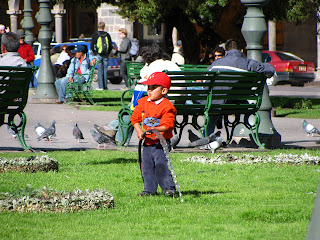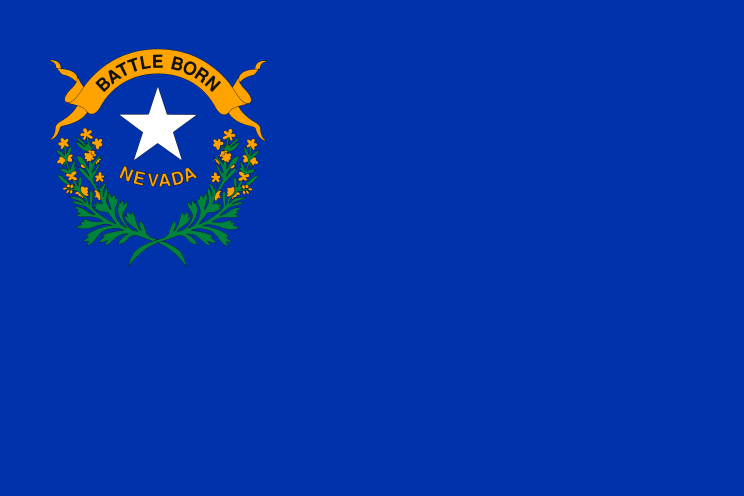getting back to Cusco from Machu Picchu, i hadn't thought we would be too interested in looking at very many more pre-Columbian ruins--or any ruins for that matter. but it turns out there's some pretty good stuff in and around the old Incan capital, so we took a look around.

old town of Cusco as seen from the nearby hills. like all Peruvian cities, big or small, Cusco has at least one plaza; this is the main one, the Plaza de Armas, on which sits the cathedral at left and a church at the far end, and is ringed in shops and cafes, many with nice balconies to sit and people-watch from. below, some of what you see while people watching; apparently they're still using child labor to keep the plaza beautiful...

one of the main things is the ruins of Saqsaywaman, located just out of town in the hills from which the first picture was taken. it's thought that only about 20 percent of the ruins still remain, so the huge area--possibly the size of a modern international airport terminal--that 20 percent covers indicates that the original site was absolutely enormous: a whole city of itself. there isn't really a consensus about what Saqsaywaman was, many think it was some form of fort, but there's no real clue as to what was being protected or from whom. in any case, there are areas with several tiers of huge stone walls and other areas of low rocks with perfectly squared cutouts that don't seem to have an obvious function. the whole thing is on a large grassy plain that is kind of fun to wander around--before the busloads of tourists show up, anyway.

some stony scenes from in and around Cusco and Saqsaywaman, clockwise from top left: Jill and the famous 12-sided stone (really, count them) set in an alleyway wall in the old town; an overview of the town and one of the hill carvings that the Peruvians seem to like so well; a rock at Saqsaywaman that appears to be in the middle of being transported to its place in the wall, see all the little stones underneath that will serve as rollers; a couple of wall shots showing more areas in which, despite the lack of mortar in constructing the walls, you couldn't fit a butter knife between the stones; Jill and i in front of part of the main body of walls at Saqsaywaman. below, some indigenous women sitting in front of yet more tightly fit stone walls back in town.

when those buses started to show up we made our getaway and walked down the pathway to town we assume the Spaniards used to cart off all the rocks they plundered from the site so they could build churches and cathedrals. one of these, the Church of Santo Domingo, was built on the ruins of an ancient temple named Coricancha, and so provides an interesting fusion of building styles. funnily enough, the stonemasonry employed in the older Incan bits are considerably more impressive than the later Spanish works, but the Spaniards introduced intricate woodworks and ornately decorated tiles to show they weren't going to be completely shown up. one very interesting thing we came across was a picture depicting the Godhead, or Trinity, as three separate persons; apparently there was a whole "Cusco School" of religious art that followed this practice but in most cases the paintings had been defaced by visiting clergy from Spain or Rome. apparently that was more offensive than the depiction of a wild chinchilla (most people think it is a guinea pig) as the main course in a famous painting of the last supper that hangs in the cathedral. go figure.

Cusco's Plaza de Armas at night, with the twinkling lights of the hillside barrios as backdrop. below, one of our favorite restaurants in town had this cool art installation depicting the famous national dish of cuy, or roast guinea pig. for some reason we were worried that eating it might make us sick, so we decided that it should be one of the last things we ate before returning to the US. as we came to find out, however, this plan was flawed in ways both very serious and laughably ironic.

we spent the rest of our time in town wandering in the hillside alleyways in the evenings, where we found some good restaurants to eat at; though we decided it was better to wait till later in the trip to enjoy cuy, the famous national guinea pig dish, we did manage to find some alpaca steaks that were quite enjoyable. they were tender and juicy and reminded me somewhat of ostrich meat of all things. there were also a lot of places advertising massages and all kind of esthetic treatments like facials and pedicures. being right up Jill's professional alley, she thought it would be very entertaining to see what a Peruvian facial was like, and so had what she described as one of the most bizarre experiences of her life at the back of a Peruvian mini strip mall.
all in all it was a fun time; we had only one full day in Cusco, which i thought was enough to see Saqsaywaman and Coricancha, but the colonial part of town was quite nice and afforded an opportunity to slow down a bit from the previous few days. as it turned out that slowness was also pleasantly far removed from what was coming up the next day too...

old town of Cusco as seen from the nearby hills. like all Peruvian cities, big or small, Cusco has at least one plaza; this is the main one, the Plaza de Armas, on which sits the cathedral at left and a church at the far end, and is ringed in shops and cafes, many with nice balconies to sit and people-watch from. below, some of what you see while people watching; apparently they're still using child labor to keep the plaza beautiful...

one of the main things is the ruins of Saqsaywaman, located just out of town in the hills from which the first picture was taken. it's thought that only about 20 percent of the ruins still remain, so the huge area--possibly the size of a modern international airport terminal--that 20 percent covers indicates that the original site was absolutely enormous: a whole city of itself. there isn't really a consensus about what Saqsaywaman was, many think it was some form of fort, but there's no real clue as to what was being protected or from whom. in any case, there are areas with several tiers of huge stone walls and other areas of low rocks with perfectly squared cutouts that don't seem to have an obvious function. the whole thing is on a large grassy plain that is kind of fun to wander around--before the busloads of tourists show up, anyway.

some stony scenes from in and around Cusco and Saqsaywaman, clockwise from top left: Jill and the famous 12-sided stone (really, count them) set in an alleyway wall in the old town; an overview of the town and one of the hill carvings that the Peruvians seem to like so well; a rock at Saqsaywaman that appears to be in the middle of being transported to its place in the wall, see all the little stones underneath that will serve as rollers; a couple of wall shots showing more areas in which, despite the lack of mortar in constructing the walls, you couldn't fit a butter knife between the stones; Jill and i in front of part of the main body of walls at Saqsaywaman. below, some indigenous women sitting in front of yet more tightly fit stone walls back in town.

when those buses started to show up we made our getaway and walked down the pathway to town we assume the Spaniards used to cart off all the rocks they plundered from the site so they could build churches and cathedrals. one of these, the Church of Santo Domingo, was built on the ruins of an ancient temple named Coricancha, and so provides an interesting fusion of building styles. funnily enough, the stonemasonry employed in the older Incan bits are considerably more impressive than the later Spanish works, but the Spaniards introduced intricate woodworks and ornately decorated tiles to show they weren't going to be completely shown up. one very interesting thing we came across was a picture depicting the Godhead, or Trinity, as three separate persons; apparently there was a whole "Cusco School" of religious art that followed this practice but in most cases the paintings had been defaced by visiting clergy from Spain or Rome. apparently that was more offensive than the depiction of a wild chinchilla (most people think it is a guinea pig) as the main course in a famous painting of the last supper that hangs in the cathedral. go figure.

Cusco's Plaza de Armas at night, with the twinkling lights of the hillside barrios as backdrop. below, one of our favorite restaurants in town had this cool art installation depicting the famous national dish of cuy, or roast guinea pig. for some reason we were worried that eating it might make us sick, so we decided that it should be one of the last things we ate before returning to the US. as we came to find out, however, this plan was flawed in ways both very serious and laughably ironic.

we spent the rest of our time in town wandering in the hillside alleyways in the evenings, where we found some good restaurants to eat at; though we decided it was better to wait till later in the trip to enjoy cuy, the famous national guinea pig dish, we did manage to find some alpaca steaks that were quite enjoyable. they were tender and juicy and reminded me somewhat of ostrich meat of all things. there were also a lot of places advertising massages and all kind of esthetic treatments like facials and pedicures. being right up Jill's professional alley, she thought it would be very entertaining to see what a Peruvian facial was like, and so had what she described as one of the most bizarre experiences of her life at the back of a Peruvian mini strip mall.
all in all it was a fun time; we had only one full day in Cusco, which i thought was enough to see Saqsaywaman and Coricancha, but the colonial part of town was quite nice and afforded an opportunity to slow down a bit from the previous few days. as it turned out that slowness was also pleasantly far removed from what was coming up the next day too...
























































No comments:
Post a Comment